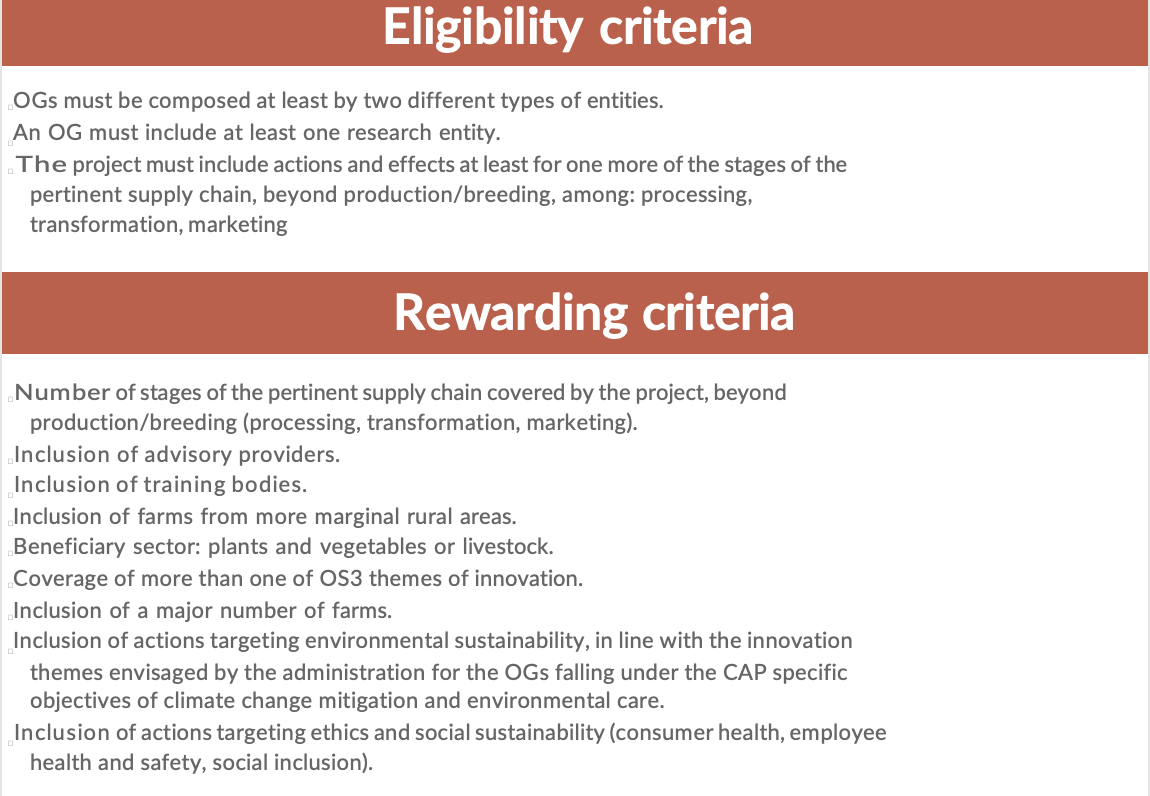2024
advisors
interaction
operational groups

The CAP 2023-2027 aims to improve farmers' position in the value chain as part of its broader goals of promoting a smart, resilient, and diversified agricultural sector. Despite the EU agri-food sector's competitive edge in global markets and its leadership in variety and quality, farmers are less experiencing growth in their share of added value within the supply chain.
The Emilia Romagna region represents an innovation ecosystem with a high potential, which agri-food supply chain is characterized by:
During the 2014-2020 rural development programming period, Emilia-Romagna invested 4.6% of total Rural Development Program (RDP) spending, the highest in Italy for innovation. Over 200 operational groups and 50 pilot projects were established to strengthen connections between the production sector and research, facilitating the implementation of innovative solutions. This initiative aimed to enhance productivity, protect biodiversity, improve environmental performance, and ensure food quality and safety.
This pathway is continued by the rural development program 2023-2027 that emphasizes the importance of agricultural quality, innovation, and relationships among supply chain actors. These elements must be integrated to support the competitiveness and sustainability of production sectors involved in agricultural raw materials. The goals include ensuring fair remuneration for producers, enhancing supply chains, improving professional relationships, and promoting cohesive, efficient, and sustainable production systems economically, environmentally, and socially.
Through the calls for applications for EIP-Agri operational groups, Emilia-Romagna Region establishes specific financial allocation, the innovation themes and selection criteria for proposals that will consistently contribute to the achievement of the CAP's SO3 “Improving farmers' position in the value chain”.
This implies that the results of the OGs selected under SO3 will contribute, together with those being selected to ‘Enhance market orientation and increase farm competitiveness’ (SO2), to the achievement of the CAP's general objective of ‘Increasing the competitiveness of the agricultural and forestry sector’.
The proposals of EIP-Agri cooperation for innovation projects must clearly indicate that they contribute to the SO3 and accordingly, they apply for one or more innovation themes that are listed by the call for applications. This list is established on the basis of the needs’ assessment carried out by the Emilia Romagna region. For example, in box 1 there’s a list of innovation themes that was defined by the call for applications launched by the Emilia-Romagna Region for year 2024. Other themes might be identified by the region for the further calls for applications.
Box 1: Innovation themes of EIP-Agri operational groups (call for applications year 2024)
- Traceability, certification and interoperability for products Made in Emilia Romagna Region and similar.
- Integrated ecosystems for the provision of value-added services.
- Market analysis and new ways of marketing agricultural products.
- Development of new varieties and product types, verification of varietal adaptability, genetic improvement schemes for quality production, enhancement of agrobiodiversity.
- Optimisation of animal feed and livestock management.
- Development of new digital applications for the management of agricultural and agri-food production processes.
- Application of remote sensing data to precision agriculture.
- Application of artificial intelligence principles and tools to agricultural production data.
- Integral mechanisation and robotics for agriculture.
- Farm and supply chain monitoring and benchmarking, both technical and economic.
- Development of organisational support and services in the supply chain.
- Applications of 4.0 technologies in product innovation in specific sectors.
- Enhancing the authenticity of raw materials and improving the quality and safety of plant and animal production (including animal welfare).
- Transfer and customisation of digitisation models between sectors and within supply chains.
- Organisational innovation, process innovation, new quality systems in agricultural, agro-industrial and forestry systems, supply chains.
- Standardisation and shared interfaces for data exchange and integration between services.
None less, among the others, some consistent eligibility and selection criteria are established by the call for applications to better shape and reward the proposals to provide an effective contribution to the SO3 (table 1).
Table 1: Eligibility and rewarding criteria
